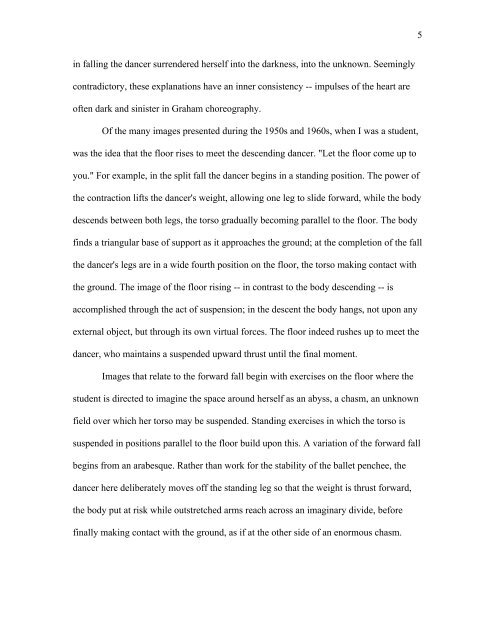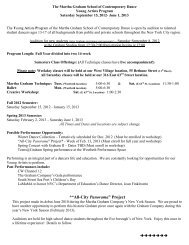1 When Your Heart Falls: The Drama of Descent in Martha Graham's ...
1 When Your Heart Falls: The Drama of Descent in Martha Graham's ...
1 When Your Heart Falls: The Drama of Descent in Martha Graham's ...
You also want an ePaper? Increase the reach of your titles
YUMPU automatically turns print PDFs into web optimized ePapers that Google loves.
<strong>in</strong> fall<strong>in</strong>g the dancer surrendered herself <strong>in</strong>to the darkness, <strong>in</strong>to the unknown. Seem<strong>in</strong>gly<br />
contradictory, these explanations have an <strong>in</strong>ner consistency -- impulses <strong>of</strong> the heart are<br />
<strong>of</strong>ten dark and s<strong>in</strong>ister <strong>in</strong> Graham choreography.<br />
Of the many images presented dur<strong>in</strong>g the 1950s and 1960s, when I was a student,<br />
was the idea that the floor rises to meet the descend<strong>in</strong>g dancer. "Let the floor come up to<br />
you." For example, <strong>in</strong> the split fall the dancer beg<strong>in</strong>s <strong>in</strong> a stand<strong>in</strong>g position. <strong>The</strong> power <strong>of</strong><br />
the contraction lifts the dancer's weight, allow<strong>in</strong>g one leg to slide forward, while the body<br />
descends between both legs, the torso gradually becom<strong>in</strong>g parallel to the floor. <strong>The</strong> body<br />
f<strong>in</strong>ds a triangular base <strong>of</strong> support as it approaches the ground; at the completion <strong>of</strong> the fall<br />
the dancer's legs are <strong>in</strong> a wide fourth position on the floor, the torso mak<strong>in</strong>g contact with<br />
the ground. <strong>The</strong> image <strong>of</strong> the floor ris<strong>in</strong>g -- <strong>in</strong> contrast to the body descend<strong>in</strong>g -- is<br />
accomplished through the act <strong>of</strong> suspension; <strong>in</strong> the descent the body hangs, not upon any<br />
external object, but through its own virtual forces. <strong>The</strong> floor <strong>in</strong>deed rushes up to meet the<br />
dancer, who ma<strong>in</strong>ta<strong>in</strong>s a suspended upward thrust until the f<strong>in</strong>al moment.<br />
Images that relate to the forward fall beg<strong>in</strong> with exercises on the floor where the<br />
student is directed to imag<strong>in</strong>e the space around herself as an abyss, a chasm, an unknown<br />
field over which her torso may be suspended. Stand<strong>in</strong>g exercises <strong>in</strong> which the torso is<br />
suspended <strong>in</strong> positions parallel to the floor build upon this. A variation <strong>of</strong> the forward fall<br />
beg<strong>in</strong>s from an arabesque. Rather than work for the stability <strong>of</strong> the ballet penchee, the<br />
dancer here deliberately moves <strong>of</strong>f the stand<strong>in</strong>g leg so that the weight is thrust forward,<br />
the body put at risk while outstretched arms reach across an imag<strong>in</strong>ary divide, before<br />
f<strong>in</strong>ally mak<strong>in</strong>g contact with the ground, as if at the other side <strong>of</strong> an enormous chasm.<br />
5



